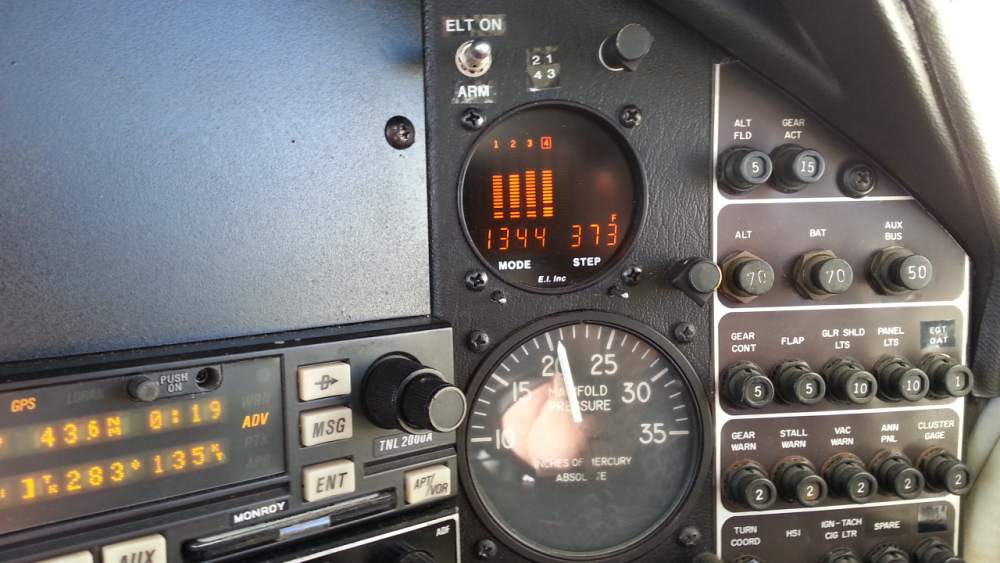-
Posts
4,785 -
Joined
-
Last visited
-
Days Won
19
Content Type
Profiles
Forums
Blogs
Gallery
Downloads
Media Demo
Events
Everything posted by Piloto
-

How much did Mooneys cost new by year/model?
Piloto replied to FloridaMan's topic in General Mooney Talk
Woow!!!! for $900,000 you can get 200 first class round trips to Europe and no need to worry about tie downs and pee bottles. José -
This Piper had over 7,000 hrs of hard landings. That is more than twice the average of old Mooneys. Aside from the wing spar the Mooney also has the structural steel tubing in the fuselage that helps on carrying the load. José
-
"TBM 930 at the show with a unique seating arrangement 4 facing forward with a toilet in the back. Not sure I’d like to give up the extra two seats." The more people you have in a plane the greater the chances someone needs to go. That's why they have four or more toilets on the airliners. I would rather have a pilot relief tube than an extra door. And some form of retractable window shades like those on the airliners. José
-
Fuel in the wing tips increases the roll angular momentum and decreases the wing flutter speed. During the Mooney long range tanks STC process I had to do 49 spins with Lucy Young the FAA pilot in different configurations with full aft CG to prove that the plane was recoverable. And Ground Vibration Test GVT to prove that the flutter frequency was not affected by the extra fuel, even though Lucy did high speed (over red line) dives to verify no wing flutter. All tests were done at 10,000ft wearing parachutes and cabin door rigged for quick release. BTW Lucy was the first female Navy combat pilot. Quite a lady. https://en.wikipedia.org/wiki/Lucy_Young José Monroy
-
Nice article. On my M20J the only time I throttle back is for descent and landing. I also noticed lower oil consumption at 2400 RPM. José
-
The drain valve F391-72 is used in all the Cessna piston planes with no issues. The F391-72 is used in the Mooney long range tanks, with no water accumulation issues. I use the F391-72 in the mains for the same reason. The safety of my family is first over others design criteria. I just disclose my findings but is up to each owner to do whatever they feel more comfortable. José
-
The interesting part is that engine failure on take off happens on piston and turbine engines. One common cause that I see is water displacement toward the fuel pickup during acceleration and climb. Airplane fuel tanks are big and prone to internal condensation or rain water leakage through the fuel caps. And when fuel is mixed with a small amount of water it can increase the power stroke significantly to exceed the connecting rod or cylinder wall stress tolerance. And when the airplane crash and burn no one is going to find any water traces except those of the fire trucks. Another factor that can damage and engine on takeoff is an intermittent spark plug, plug cable or magneto. If there is no ignition during a power stroke on the next power stroke there could be more fuel in the cylinder causing a greater explosion thus more stress and failure. Reducing power after takeoff will not harm the engine but pulling on the mixture rather than the throttle could cause engine stall or damage. Normally your right hand is on the throttle during takeoff but when you move your hand to the gear switch or lever it may not return back to the throttle but to the mixture. Always visually check. On some older Mooneys the mixture or throttle control can creep back in-flight due to vibration. Before the takeoff run verify full RPM and MP. Not having enough power and heavy on weight may cause partial lift on ground effect but not enough to clear the trees. Weight is a significant factor on takeoff. If the runway is less than 2,000ft do not fill more than 1/2 tank. José
-
Another crash on takeoff https://www.aerotime.aero/en/military/21129-breaking-algerian-military-transporter-crashes-200-feared-dead José
-
I you are using the F391-53S valve have it unscrew at every annual and check for water accumulated. Or you will be on the news. http://abcnews.go.com/US/killed-plane-crash-famed-golf-arizona/story?id=54356600 José
-
The F391-53S will still drain with the bottom holes plugged but from the top of the stem. The drain plate holes will eventually get plugged by tank debris or sealant. If the valve is not aligned with the drain plate holes smaller debris can block the flow. On the F391-72 the holes are just above the drain plate thread in clear contact with the fuel. As the plane ages debris accumulate around the drain plate raising the bottom height of the tank. On some older Mooneys the bottom of the tank is level with the top of the thread of the drain plate. José F-391-72 Drain Valve
-
Mine failed on take off at KFLL, luckily I had enough runway left to put it down. The cause was water in the tank even though I drained the tanks prior to flight. The problem was due to drain plate drain holes plugged at tank reseal. This cause the drain valve to drain from the top of the valve instead from the bottom drain hole, leaving water below un-drained. Even though this water level will not impair the engine from starting or taxing as the plane accelerates and rotates this water shift toward the back where the fuel pick up is located causing the engine to stall. I replaced the F391-53S drain valve with the F391-72 drain valve, same one used in the long range tanks. The F391-72 has the drain holes just above the thread drain plate directly exposed to the fuel in the tank so they are not impaired by sealant or debris. José
-
Antenna icing susceptibility depends on the antenna type. Bare wire antennas are the most susceptible ones. They essentially get shorted to ground when ice covers them at the base. Least susceptible ones are the ones with the radiating element encapsulated (blade antennas). For patch antennas like GPS or XM/WX and COM blades is best to apply Rain-X before the trip to reduce the possibility of icing. Airliners have heated air conduits antennas. José Wire Antenna Encapsulated Antenna
-
When I installed my UBG-16 I recall the fuel flow module had an adjustment to calibrate the reading while measuring flow. I adjusted the module to read the same as my previous flow meter with the electric fuel pump on open throttle and full rich mixture. Another method is to time how long it takes to fill a one gallon container. Disconnect the fuel line from the carburetor Insert the line to a 1 gallon container. Set your stop watch and turn on the electric pump. Stop your watch when the container reach 1 gallon. GPH = 3600/seconds For 5 gph it would take 12 minutes or 720 seconds. José
-
Impressive video. I noticed that you went directly from CYYT to LPHR. I thought that LPAZ was the only airport of entry to the Azores. I guess LPHR has Customs now. What type of HF radio and antenna did you used for the trip? José
-
Woow, amazing trip. Post any pictures you may have. José
-
The impact pressure on the wing TKS surface is greater than the static pressure on the TKS tank as altitude increases. Because of the pump limited capacity this causes a flow reduction. A bigger pump would solve the problem but risk bursting the lines. Similar problem happens with vacuum systems at altitude and why the use of electric gyros on the flight levels. José
-

Overhaul vacuum A/H or spring for Aspen MFD?
Piloto replied to 231LV's topic in Modern Mooney Discussion
Slow gyro erection is very much related to low vacuum. Check vacuum suction at altitude, if below 5"Hg have the vacuum regulator adjusted to 5.5" or replace the pump. Check also for kinks on the vacuum hoses. José -
Try Rain-X de ice fluid https://www.amazon.com/RAIN-RX68106-ICER-WASHER-FLUID/dp/B001DQA89S/ref=sr_1_1?ie=UTF8&qid=1523039173&sr=8-1&keywords=rain+x+de+icer Tested by over 100 million cars in the US. José
-
Try elevator shoes. https://www.tallmenshoes.com/winterseries.html?utm_source=msn&utm_medium=cpc&utm_campaign=(roi)+elevator+shoes&utm_content=elevator+shoes+for+men&utm_term=elevator shoes for men&utm_creative=e&utm_device=c&msclkid=b9df35934209122d09db6f54faaa79a8 Cheap and easy to install. José
-
Marine seals are the best, you will not sink when you ditch. José
-
With the 201 you will never have a turbo problem, neither two extra cylinders to worry about. I have gotten my 201 up to 19,000 feet but just my self on it. Keep in mind that flying at high altitudes you have a good chance of facing strong headwinds. Myself I prefer reliability over performance, a flying 201 is much faster than a 231 in the shop. José
-
Silicon WD-40 https://www.webstaurantstore.com/wd-40-300012-specialist-11-oz-water-resistant-silicone-lubricant-spray-with-smart-straw/999300011.html?utm_source=bing&utm_medium=cpc&utm_campaign=Shopping HP&utm_term=1100404859972&utm_content=Janitorial José
-
If dirt gets into a hole how it will come out with no lubricant in it? Dirt does not stick to WD-40 like oil or LPS. I have used it in the marine and aviation environment for over 40 years with excellent results. Just try it, for $5 a can is worth the trial. Some suggested Mouse Milk but I am against animal cruelty after I learned how it is produced. José
-
To reduce the wear on the seat tracks and mechanism had them lubricated. I always spray WD-40 at every annual. Also to insure proper seating of the seat pegs on the tracks keep the track holes clean. When the peg is not fully inserted due to dirt in the hole there is a chance of the seat sliding back. José
-
Your assumption is not valid for the M20C and E since there is a gap between the mains and LR on these models. José




